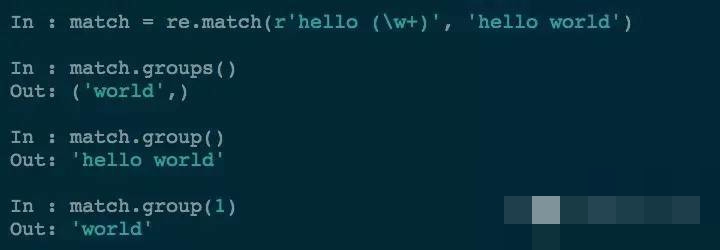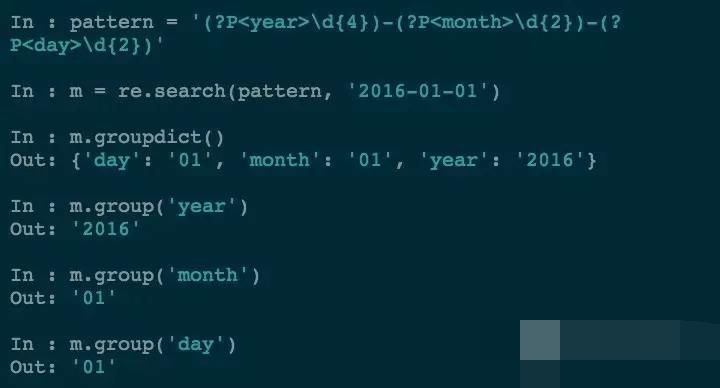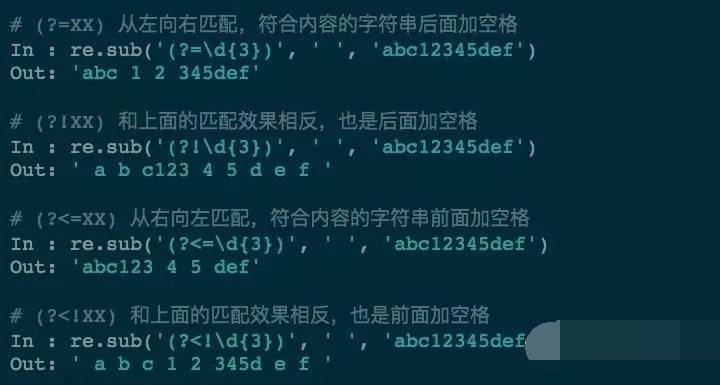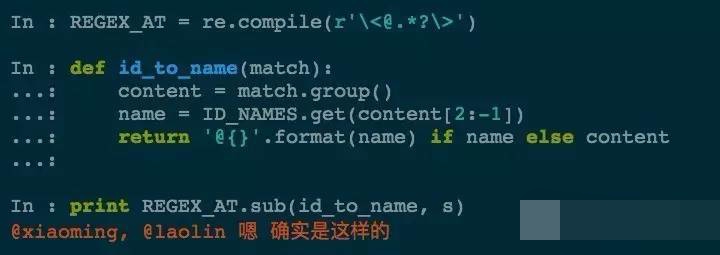Advanced usage of Python regular expressions
For Python, learning regular rules requires learning how to use the module re. This article will demonstrate some advanced techniques that everyone should master.
Compile regular expression object
The re.compile function generates a regular expression object based on a pattern string and optional flag parameters. This object has a series of methods for regular expression matching and replacement. There are slight differences in usage. For example, to match a string, you can use the following method:
If you use compile, it will become:
Why do you need to use it like this? In fact, it is to improve the speed of regular expression matching and reuse regular expression objects. Let's compare the efficiency of the two methods:
You can see that the second method is much faster. In actual work, you will find that the more you use compiled regular expression objects, the better the effect will be.
Group
You may have seen the use of grouping matching content:

Pass Add parentheses to the objects to be matched to accurately match the results. We can also perform nested grouping:

Grouping can meet the needs, but sometimes the readability is poor, then the grouping can be named:

Now the readability is very high.
String matching
Students who have learned sed may have seen the following replacement usage:
This \1 represents the result of the previous regular match. The above sed is to add square brackets to the matched results.
There is also such usage in the re module:
It is also possible to use named grouping:
Nearby matching (Look around)
re module also supports nearby matching, just look at the example to understand:

Use the function when doing regular matching
Most of what we've seen before matches an expression, but sometimes the requirements are much more complex, especially when it comes to substitutions.
For example, chat records can be obtained through Slack's API, such as the following sentence:
Among them <@U1EAT8MG9> and <@U0K1MF23Z> are two real users, but Encapsulated by Slack, you need to obtain this correspondence through other interfaces.
The result is similar to this:
After parsing the correspondence, I also hope that the angle brackets are also removed. The result after replacement is "@xiaoming, @laolin Yes, it is indeed like this"
How to use regular expressions to achieve this?

So of course pattern can also be a function
For more articles related to the advanced usage of Python regular expressions, please pay attention to PHP Chinese net!

Hot AI Tools

Undresser.AI Undress
AI-powered app for creating realistic nude photos

AI Clothes Remover
Online AI tool for removing clothes from photos.

Undress AI Tool
Undress images for free

Clothoff.io
AI clothes remover

AI Hentai Generator
Generate AI Hentai for free.

Hot Article

Hot Tools

Notepad++7.3.1
Easy-to-use and free code editor

SublimeText3 Chinese version
Chinese version, very easy to use

Zend Studio 13.0.1
Powerful PHP integrated development environment

Dreamweaver CS6
Visual web development tools

SublimeText3 Mac version
God-level code editing software (SublimeText3)

Hot Topics
 1378
1378
 52
52
 How to solve the permissions problem encountered when viewing Python version in Linux terminal?
Apr 01, 2025 pm 05:09 PM
How to solve the permissions problem encountered when viewing Python version in Linux terminal?
Apr 01, 2025 pm 05:09 PM
Solution to permission issues when viewing Python version in Linux terminal When you try to view Python version in Linux terminal, enter python...
 How to efficiently copy the entire column of one DataFrame into another DataFrame with different structures in Python?
Apr 01, 2025 pm 11:15 PM
How to efficiently copy the entire column of one DataFrame into another DataFrame with different structures in Python?
Apr 01, 2025 pm 11:15 PM
When using Python's pandas library, how to copy whole columns between two DataFrames with different structures is a common problem. Suppose we have two Dats...
 How to teach computer novice programming basics in project and problem-driven methods within 10 hours?
Apr 02, 2025 am 07:18 AM
How to teach computer novice programming basics in project and problem-driven methods within 10 hours?
Apr 02, 2025 am 07:18 AM
How to teach computer novice programming basics within 10 hours? If you only have 10 hours to teach computer novice some programming knowledge, what would you choose to teach...
 How to avoid being detected by the browser when using Fiddler Everywhere for man-in-the-middle reading?
Apr 02, 2025 am 07:15 AM
How to avoid being detected by the browser when using Fiddler Everywhere for man-in-the-middle reading?
Apr 02, 2025 am 07:15 AM
How to avoid being detected when using FiddlerEverywhere for man-in-the-middle readings When you use FiddlerEverywhere...
 What are regular expressions?
Mar 20, 2025 pm 06:25 PM
What are regular expressions?
Mar 20, 2025 pm 06:25 PM
Regular expressions are powerful tools for pattern matching and text manipulation in programming, enhancing efficiency in text processing across various applications.
 How does Uvicorn continuously listen for HTTP requests without serving_forever()?
Apr 01, 2025 pm 10:51 PM
How does Uvicorn continuously listen for HTTP requests without serving_forever()?
Apr 01, 2025 pm 10:51 PM
How does Uvicorn continuously listen for HTTP requests? Uvicorn is a lightweight web server based on ASGI. One of its core functions is to listen for HTTP requests and proceed...
 How to dynamically create an object through a string and call its methods in Python?
Apr 01, 2025 pm 11:18 PM
How to dynamically create an object through a string and call its methods in Python?
Apr 01, 2025 pm 11:18 PM
In Python, how to dynamically create an object through a string and call its methods? This is a common programming requirement, especially if it needs to be configured or run...
 What are some popular Python libraries and their uses?
Mar 21, 2025 pm 06:46 PM
What are some popular Python libraries and their uses?
Mar 21, 2025 pm 06:46 PM
The article discusses popular Python libraries like NumPy, Pandas, Matplotlib, Scikit-learn, TensorFlow, Django, Flask, and Requests, detailing their uses in scientific computing, data analysis, visualization, machine learning, web development, and H




